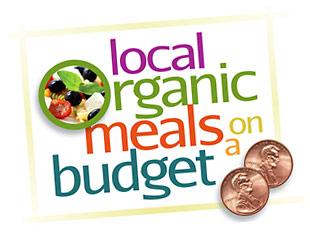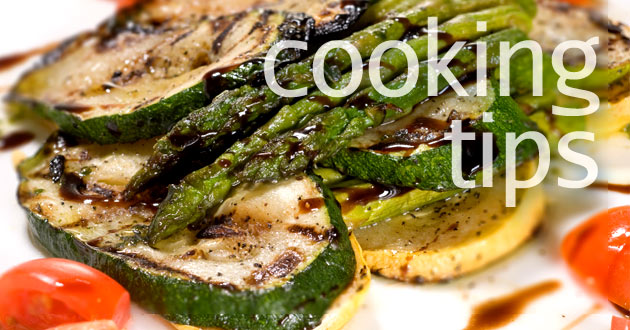Cooking tips
Cooking your own meals dramatically lowers the cost of local and organic eating when compared to fast food, prepared/processed foods, or restaurants and take-out. Our recipes are quick and easy and show you how much each meal costs. And cooking with the seasons helps to save money since the abundance of a harvest drives cost down.
Click on a topic below to read more:
- Local and organic recipes
- Food prep tips & cooking techniques
- Cooking strategies to stretch your dollars
- Seasonal foods: Fresher and less expensive
- Setting up a local and organic pantry
- Meet Mark, a local organic fan
Food prep tips & cooking techniques from our chefs
1) To peel ginger, use a spoon with a thin edge. Hold the piece of ginger in one hand and with the other hand run the spoon edge along the peel. The ginger peels can be used to make ginger tea.
2) Garlic can get bitter if browned, so be careful not to sauté it too long. You can also add garlic to a dish later in the cooking process for a brighter flavor.
3) To seed a pomegranate, first half it at the equator. Hold half over a bowl, tap the outside of the fruit with a spoon and the seeds will just fall out.
4) Try new herbs and spices by buying a small amount in bulk. Instead of buying an entire jar, the smaller quantities will be used more quickly and be fresher. You can try them out in your cooking and then buy more if you like them.
5) Homemade stock, pesto, and fresh herbs in water can be frozen in an ice cube tray for later use. The cubes can be added as needed to dishes, and stock cubes can be used as bouillon for soups or sauces.
6) It is much easier to scrape roasted winter squash than it is to peel. Use a small spoon to scrape the cooked squash and then put the squash through a sieve to remove any remaining strings and skin. Winter squash purees can be mixed together and then frozen in small batches for use at a later date.
7) Make dessert first when cooking a meal. If you're using the same cutting board, this will prevent the flavor of garlic, onion and aromatic herbs used in the main dish from impacting the taste of the dessert.
8) When cooking fresh asparagus, hold one end of a spear in each hand and bend it until it snaps in two towards the thicker bottom portion of the spear. This removes the thick woody portion which won't completely cook and will be tough and fibrous. Save the unused ends in the freezer and add them to your stock.
9) Crisp, al dente vegetables: Blanching and shocking. Prepare a pot of boiling water and a pot of cold water. Drop veggies into the boiling water and cook just until you see the color change to a bright hue, then take them out and throw them into the cold water. This par cooks the veggies, so if you want to go back and sauté them, you can without overcooking them. You'll enjoy an ‘al dente’ finish while still keeping the vegetables flavorful.
10) To make a simple vinaigrette dressing, use one part vinegar to two parts oil. You can add other ingredients to an easy olive oil and red wine dressing, such as mustard, herbs, salt and pepper, etc. to give it a more complex flavor.
11) A natural substitute for aluminum foil is corn husks! Soak them in water and use them instead of foil for cooking and wrapping foods.
And remember: the sweetest corn and the sweetest apples are the ones that attract the worm, so enjoy the edible parts!
Cooking strategies to stretch your dollars
Here are two blogs that demonstrate how you can stretch your food dollar with resourceful recipes. Hopefully, they'll inspire you to get creative with your own meals and weekly menus!
1 Chicken, 17 Healthy Meals, $26 Bucks, No Mayo
Trying Out Martha Stewart's 5 Meals For $50.00
Let us know if you find any interesting links that you'd like to share. Email us.
Seasonal foods: Fresher and less expensive
Eating with the cycles of nature is a way to get the freshest food at its natural peak. Our classes will revolve around what's available locally during each season.
Here's a guide to what's in season and nutritional benefits compiled by Santa Fe Nutritionist Laura McCann.
Click to see what's available right now at the Santa Fe Farmers Market.
Build up a local & organic pantry
Having a well-stocked pantry or just some basic staples in the house means that you can shop for fresh vegetables, poultry and meat and come home and create the rest of the meal from your pantry. Here are some suggestions to start with:
• Beans (black, pinto, garbanzo, kidney, etc. dried and canned)
• Chicken / vegetable broths
• Flour (unbleached; whole wheat preferable)
• Garlic and Onions
• Herbs and spices (basil, oregano, parsley, ground cumin, chili powder, sea salt, black pepper, cinnamon, etc.)
• Nuts and Dried Seeds (walnuts, pumpkin, sesame…)
• Oatmeal and other whole-grain cereals
• Olives
• Pasta (whole wheat)
• Raisins / other dried fruits
• Rice (brown)
• Soy sauce (low sodium)
• Tomatoes / Tomato Sauce (pref. organic in glass jars)
• Tuna / Salmon (canned)
• Vegetable Oil (olive, canola…)
• Vinegar (red wine, balsamic, try others)




